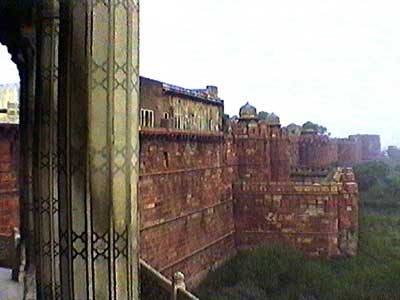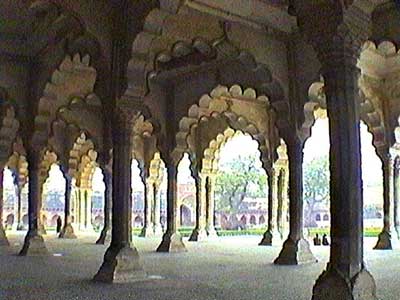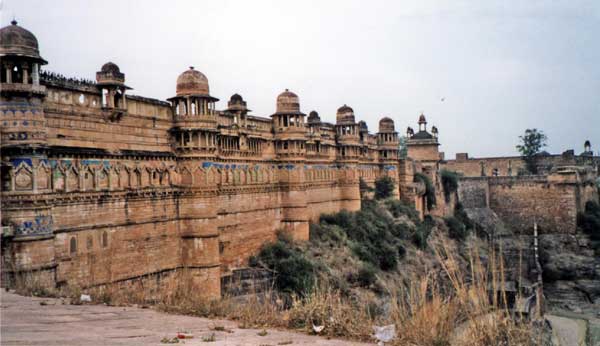GWALIOR (Day 9)
Mosquitoes all night, religious chanting at 5 am, hotel and traffic noise at 7 am, people singing pop songs next door... it was a very unrestful night. Breakfast consisted of some bananas and oranges that we bought on the street on the way.

A typical street
Our first site of the day was the Agra Fort. Also called the Red Fort or Lal Qila, it was built by Akbar in 1565 and later added to by Shah Jahan, who made it more palace-like instead of just a massive fortress.
We had to fight our way through very persistent street vendors before we could actually get into it. Clearly we were now seeing the more popular tourist attractions. We crossed over a small drawbridge and into the fort. Small grey monkeys, dogs and bees were abundant. We passed through several large gates and up several steep slopes but eventually we reached the beginning of this HUGE extensive place.
From the massive fort walls, we could see the Taj Mahal in the misty distance. It gave the odd feeling of being on top of the world. Migrating cows in the distance had the appearance of a traveling herd of dinosaurs crossing the flat sandy banks of the floodplain of the Yamuna River. There was no getting into this fortress: first it was built on a hill, second it had a water moat, third there were many smaller walls before reaching the huge main fort wall. Green parrots rested in the palm trees that filled the spaces between the inner walls.


The moat and giant protective walls that extend for 1 1/2 miles


Not only were there plenty of tourists, there were also plenty of people working. Since India was always very dusty, there were people sweeping everywhere. Other people were busy with repair work, gardening, cutting stones and cleaning. Piles of bricks and pipes lay about in side rooms while various makeshift scaffolding covered some walls.

Sweeping
There were plenty of ornate red stone carvings and decorative inlay. The large white marble inner palaces were hooked together to form a giant maze. Courtyard after courtyard was connected by narrow dark passages and small staircases. Small gardens and several grassy courtyards were surrounded by various columns and arches. There were also many fountains and small waterfall baths but they weren't working.




We then visited a stone inlay shop and were given a complete tour from the uncut stones to the finished inlay product. We first saw how they ground the stones such as malachite, lapus lazuri and Indian jade. The grinding stones were turned using a stick tied to the stone with the right hand (which they pulled back and forth) while their left hand held the precious stone to the grinding wheel. For the inlay work, they cut the small stones into various shapes (leaves, etc). They then place these on a piece of marble that had been painted red. After tracing the shape of the stone onto the marble, it was then chiseled out. When all the pieces had been cut, the stones were glued in (using glue made from trees). The red paint was washed off and the whole thing was polished.
When it came time to buy something, we were escorted into a room with many large marble tables, serving trays, etc. The price range, however, was in the tens of thousands of dollars. Once we made it clear there was NO way we could afford something like that (regardless whether they would ship it directly to our home or not), we were led into a second room with smaller items (like ring boxes, etc). But these were still quite pricey. Amazingly enough, there was still a third room that had items made from a different (cheaper) marble instead of the white stuff used to build the Taj. We ended up buying a beautifully shaped box with a lotus flower inlay on top for $5.
That led us to our next stop. Since we were seriously concerned as to whether our funds would take us through the rest of the trip (the car had thrown us way off budget), we stopped at a bank to withdraw some money. It was a very dingy shady place. We went upstairs and patiently waited while a man checked in all his old ledgers and filled in forms in triplicate (no computers here). The small room was dimly lit by weak fluorescent lights and had eight desks squeezed in. A man carrying a large shotgun paced about. Eventually all the necessary papers were signed and we were given a gold token which could be traded in for cash from the tellers downstairs.
We grabbed some quick snacks for the road like katchury (an oily hollow pastry), peanut brittle and dried peas. All the food is served in small sacks of folded newspaper pages that people then just throw on the ground or out the car window. Eventually it is all eaten up by wandering cows.
We continued our drive eastward, through the "Indian badlands" with its steep hills and sparse shrubbery. Overall, the landscape was much much greener with many deep green crops and plenty of trees. We were stopped three times to show all the permits and papers of proof of paying tax in this province.
Along the way, we saw many people on a long pilgrimage walking to the Ganges River for the Holi festival ('festival of colors') that started in a few days. They were carrying ox harnesses across their shoulders, all covered with bells and colorful decorations. We learned they were never to let the harness, which would later be carrying back buckets of holy water, touch the ground... and some of these guys would be walking for days and days!
Finally we arrived in Gwalior... just in time for an election. People filled the streets as did all sorts of campaign signs. After a very stressful time of driving in circles, we eventually found our way up to the fort on the hill. We reached a toll booth and had to buy some tickets before continuing on up.
The city's most important rulers were the Tomar-Rajput from 1398 - 1519. One of them, Raja Man Singh (1486 - 1518) built this HUGE fort on the hill... almost 2 miles long. Most of it was very run down, an abandoned city of temples and palaces. The tall wall was most impressive, with a thickness of 30 feet in some places. It was still quite dangerous to walk along though because of the constant holes that go through to the ground far below. We wandered some more, eventually getting lost through the thick underbrush and having to turn back.


The main gate or Hatya Paur (the elephant gate) was beautifully carved with elephant and duck images.

Cows grazed in some of the back areas of the fort.
We sat for a bit, overlooking the fort for a while, but eventually we began to feel a bit uncomfortable... not due to all the slowly circling vultures but rather from all the calls of 'goria' ('pale people'). This was not your usual white tourist place.
We continued on our way and got as far as Jhansi before it got dark and we needed to find a hotel. The room was ok with the exception that there were no windows, only open vents that lead to the next room next door. There were also no (only thin rough blankets) and lots and lots of mosquitoes. Oddly enough, the master light switch was OUTSIDE the room in the hall.
return • continue

